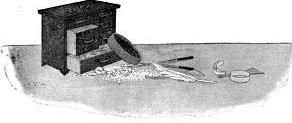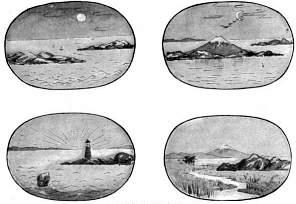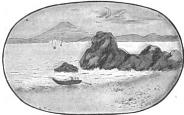
A Japanese outfit for making sand pictures

|
"Japanese Sand Pictures" by Florence Peltier Pope (1907):
THE young people in Japan take a great deal of pleasure in
making sand pictures -- bon-seki they call them. Besides a black lacquered tray (a tin tray painted black will do quite
as well) the materials required are stones of various sizes and shapes and all sorts of pebbles; fine and coarse sand in
its many shades; molds shaped like the crescent moon, the full moon, and flying birds, that may also bo made of wire bent
into the requisite shape; a feather, a spoon, two small sieves, a small, very sharp-pointed stick, and a pair of tweezers,
in place of the chopsticks the Japanese use, to pick up pebbles to deposit in place. 
Sand pictures easy to copy Figure 3. A moonlight effect with sand and stones Figure 4. White sand makes the bald mountain top Figure 5. A sunrise scene in black and white Figure 6. A landscape not so difficult as it appears One can allow one's fancy great scope in this work and make charming and original pictures that would afford a pleasing addition to the adornment of any room. Properly handled, a bon-seki would even form a pretty centerpiece for the dining room table. 
Figure 1. A simple study in black and white Trays of various sizes may be used, but the most satisfactory results will be obtained with one that is about a foot and a half in length. Figures 3, 4, 5, and 6 are pictures to copy in sand and stones. In Figure 3 the islands in the middle distance are made by piling up ragged stones. The rest of the tray is scattered over with fine sand of a light tint, except on the further side of the tray, where a darker sand may be used to represent the night sky. A little white sand scattered over the part of the surface representing water appears as moonlight. The full moon is a mold filled with white sand; or a circle may be drawn, the sand within the circle removed, and the space filled in with white sand. Waves, clouds, horizon line and tiny boats are drawn in the sand with the sharp-pointed stick. Waves may also be made with the back of a spoon near its point, by pushing the sand into shapes of waves. Figure 4 has for the middle distance two islands built [45] of stones, and one island is topped by a mountain, made by heaping up pebbles and covering them with sand. The snowy summit is white sand. The distant land on the horizon is filled in with dark sand. The picturing of moon and sailboats has already been explained. The birds are drawn by means of the sharp stick. If white birds are wanted wire can be shaped to resemble their outlines, placed in position on the tray and filled with white sand. Figure 5 pictures a large rock in the foreground and a ledge of rocks in the middle distance. The lighthouse can be cut out of wood or built up with pebbles. There are low hills on the horizon to be treated the same as those in Figure 4. The sky should be of lighter sand than that representing the water, and the outlines of the sun and its rays are drawn with the stick. Figure 6 is complicated, but it is easy to make. The sky is of fine light-colored sand, the mountains and ground of darker sand. The stream is first outlined, then the sand between the outlines is removed, and the space filled in with white sand, to represent water. There are some very rough stones in the middle distance. The group of trees is "drawn" by manipulating the sand with a feather. The reeds are outlined with the stick. It is not necessary to have more than the simplest idea of drawing in order to make these sand pictures, and any drawing or photograph of a landscape, not too intricate in composition, may be easily copied. To one having what the Japanese call "the picture mind," this novel art offers a delightful occupation. 1 
Figure 2. The tray showing completed picture |
|
1 Pope, Florence Peltier "Japanese
Sand Pictures," Good Housekeeping, Vol. XLV, No. 1, July 1907, pp.
43-45.
Illustrations by Genjiro Yeto. The order of the figures above matches how they are presented in the original article.
|